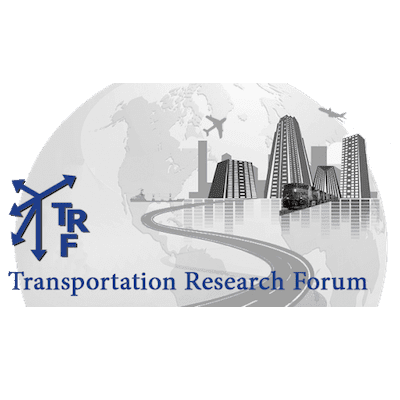3 May 2021
Session 331: Innovations in Incentivized Ridesharing and Congestion Pricing
Before the pandemic government institutions and transportation specialists were looking at solutions other than just infrastructure to help reduce congestion, single occupancy vehicle use, and increasing levels of carbon emissions from automobiles. The Pandemic has seen an increase in car commuting, single occupancy, and more congestion. The latest transit census of commutes before the pandemic indicated 76% of ridership are solo drivers, 9% carpool, 5% use public transit, 5% work from home and 5% use other modes (walking, biking, ride-hailing).
The goal is to determine what will motivate the 75% to become passengers where the majority of unused transit seats are in single-occupancy vehicles and not on public transit.
Four studies were presented at the International meeting of the Transportation Research Forum that provided insights into Incentivized Ridesharing to Manage Congestion and Provide Access to Jobs. Here are the summarized findings:
Study 1: Congestion Clearing Payments to Passengers
(Paul Minett, Chief Executive Officer, Trip Convergence Ltd., Auckland, New Zealand)
The purpose of this study would be to determine if people would be willing to travel as passengers, commute with passengers, and at what cost?
- 50% of drivers who use congested routes would be willing to travel as passengers for an incentive-based reward (up to $15 per day).
- 23% of drivers would be willing to commute with passengers or with passengers for an incentive-based reward (up to $15 per day).
- 27% of drivers prefer driving alone.
The study also looked at the approximate costs of eliminating congestion over a twenty-year period and projected that for every dollar spent there would be a four and a half dollar benefit.
Study 2: Rewarding Drivers for Providing the Transportation Disadvantaged with Rides to Work Sites
(Charles H. Apigian, Director, Data Science Institute at Middle Tennessee State University)
Through a partnership with the Data Science Institute at Middle Tennessee State University, an analysis of the data was conducted to provide better insights into ridesharing patterns, the role of an incentive, and factors that go into building the habit of peer-to-peer mobility. It also investigates the role of paying individuals to carpool to reduce traffic, provide reliable transportation that is carbon neutral, and different from the traditional ways of public transportation. This rich dataset also shows the effects of removing or increasing the cash incentives, its implication for creating a carbon zero ride, and a better understanding of how changing ridership habits will positively influence a community.
Here are the findings of the large-scale and comprehensive study done between January 2018-December 2019 for market-based ridesharing in Nashville using the Hytch Rewards app.
- Market-based incentives should reach 20 or more rides per user (average achieved in 1 month).
- The first month is best sustained if the incentive is between $0.02 - $0.05 per mile.
- Therefore the cost per user at $0.02/mile is $3.54 and at $0.05/mile is $8.85.
- To incentivize 1,500 users the costs would be $5,310 and $13,275 for $0.02/mile and $0.05/mile respectively.
Study 3: Combining Freeway Network-Wide Congestion Pricing with Incentivized On-Demand Ridesharing.
(Patrick DeCorla-Souza, Former co-chair of TRB Congestion Pricing Committee and P3 Program Manager at USDOT’s Build America Bureau and FHWA’s Center for Innovative Finance Support)
The concept presented in this presentation is that toll revenue from congestion pricing is used to provide cash incentives for ridesharing which exceed the value of congestion-based tolls. And on-demand ridesharing using a mobile app makes it easy
for drivers and passengers to form carpools without prior arrangements and provides a viable, affordable alternative to address concerns of those who don't want to pay tolls and work in locations not well-served by transit.
Findings based on a study by the Mineta Transportation Institute:
- $5.00 cash payment would attract 15% of solo-commuters to become carpool drivers for their morning trip.
- 15% of solo drivers would be willing to ride as a passenger with a daily cash incentive of $1.00 (or 50 cents for a one-way trip) if it were easy to ride as a passenger.
Thus, a public subsidy of $5.50 to commuters in a 2-person carpool is estimated to result in a reduction in commuter traffic of 15%
Study 4: Cashing Out HOV Toll Exemptions on the I-66 Managed Lanes inside the Capital Beltway: An Exploratory Analysis.
(Sara Zahedian, Graduate Research Assistant at the Center for Advanced Transportation Technology (CATT), University of Maryland)
The concept involves “cashing out” HOV toll exemptions on HOT lanes, i.e., paying carpoolers the average value of their toll exemptions rather than exempting them from tolls. The key components of the cash out concept are:
- Limits to Toll Exemptions
- Carpool Incentives
- On-Demand Ridesharing
Key findings:
- SOV, HOV-2, and HOV-3+ traffic volumes for each scenario are presented for the morning peak period. While HOV-2 volumes drop significantly under HOT-3, much of the loss is regained under HOT-3 with cash out.
- Likewise, there is a significant drop in person throughput under HOT-3, but much of the loss is regained under HOT-3 with cash out.
- Net revenue increases significantly under both HOT-3 and HOT-3 with cash out, but the increase is somewhat lower under HOT-3 with cash out.




